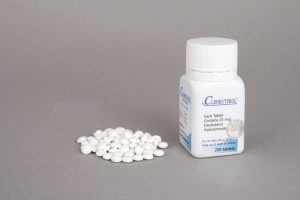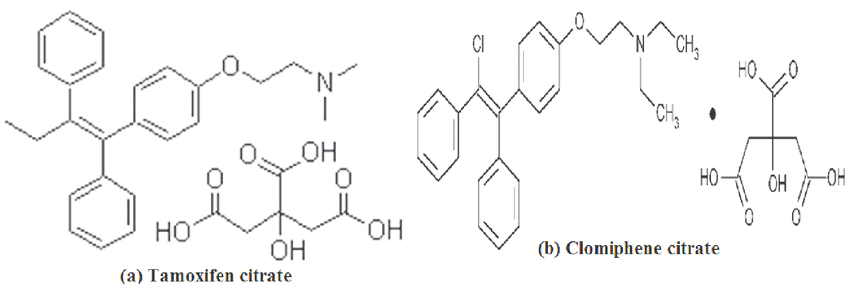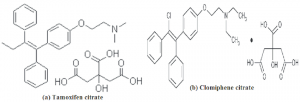
Clenbuterol hydrochloride – What makes Spiropent® 0,02 mg so popular
Clenbuterol is a substance coming from a group of compounds called beta2-agonists. Compounds belonging to this category can promote dilation of the bronchial muscles. However,

Antiestrogens are a class of drugs that prevent estrogens from mediating their biological effects in the body. They are also known as estrogen antagonists or estrogen blockers. Antiestrogens function by blocking the estrogen receptor and/or suppressing estrogen production. The medical uses of antiestrogens include male hypogonadism, Ovulation induction in infertility due to anovulation, Estrogen deprivation therapy, gynecomastia, etc.
However, ant-estrogens are extremely popular among anabolic steroid users. They use these compounds to manage the estrogenic side effects brought on by some anabolic steroids. Steroid users use antiestrogens during PCT to restore their natural testosterone levels as well.
In this blog post, we are going to talk about two of the most popular anti-estrogens: Tamoxifen and Clomid. We will see how these compounds can help you deal with the estrogen-related side effects of steroids. We will also do a comparison of these two anti-estrogens. So, if you want to learn more about these anti-estrogens, then consider going through the full post properly.
Tamoxifen Citrate is one of the most popular anti-estrogens that steroid users use. It is actually a SERM or Selective Estrogen Receptor Modulator. It was created in 1961. This medication is sold under numerous brand names. However, Nolvadex is the most popular one.
The most important thing about Tamoxifen Citrate is that it is both an antagonist and an agonist. It acts as an anti-estrogen in some parts of the body and as an estrogen in other areas.
Tamoxifen has been used for therapeutic purposes for a long time. It has been highly successful in the treatment of hormone-responsive breast cancer. It has become popular among anabolic steroid users due to its anti-estrogen properties. It helps steroid users manage the estrogen-related side effects that occur as a result of administering steroids.
Tamoxifen Citrate is usually used during PCT or Post Cycle Therapy. PCT helps regulate the production of natural testosterone that is suppressed during steroid use.
Below, we are going to discuss the functions, effects, dosage, and side effects of Tamoxifen Citrate. Consider going through all the sections below to learn about this antiestrogen in detail.

As mentioned earlier, Tamoxifen Citrate acts as both antagonist and agonist in relation to estrogen. It functions by binding to estrogen receptors in some parts of the body such as the mammary tissue. Due to this, estrogen can’t act on its originally intended point of binding. It is the reason why Tamoxifen Citrate has been successful in treating breast cancer patients. Also, it helps steroid users manage issues like gynecomastia that occur due to increased estrogen levels in the body.
It also acts as an estrogen in certain parts of the body. It works by acting as an estrogen on the liver. It results in improved cardiovascular health. This is another way Tamoxifen Citrate benefits steroid users. Most anabolic steroid users affect cardiovascular health by increasing LDL levels and suppressing HDL levels. Tamoxifen helps steroid users deal with this issue.
Tamoxifen Citrate also has strong testosterone-stimulating properties. It stimulates the pituitary. This leads to increased production of LH (Luteinizing Hormone) and FSH (Follicle Stimulating Hormone). LH and FSH are responsible for testosterone production.
Anabolic steroid users can use Tamoxifen Citrate both during and post steroid use. However, as mentioned earlier, it is primarily used during PCT.
Steroids that convert into estrogen such as Testosterone, Nandrolone, etc. increases the estrogen levels in the body. This conversion occurs because the testosterone hormone is metabolized by the aromatase enzyme. It leads to problems like gynecomastia or enlargement of breasts in men, water retention, etc. Users may also experience high blood pressure.
However, Tamoxifen Citrate doesn’t work by lowering estrogen levels. Instead, it binds to the receptor. It stops the estrogen from binding. So, it may not help you deal with water retention. But it can help you manage gynecomastia. Nevertheless, it may not provide strong gynecomastia protection. Men who need stronger protection can consider using AIs or Aromatase Inhibitors. AIs work by inhibiting aromatase activity and lowering estrogen levels.
The testosterone stimulating effect is another important effect of Tamoxifen Citrate that you need to consider here. The production of natural testosterone is suppressed when you take steroids. And this is true for all anabolic steroids. Steroids work by signaling the pituitary to stop producing LH and FSH. It is one of the main reasons why it’s advised to include exogenous testosterone in the plan. It helps prevent the low testosterone condition.
When we discontinue steroid use, it takes a lot of time for the body’s natural testosterone levels to get restored back to normal. Though the natural testosterone production will begin automatically post steroid use, the process will be slow. So, you need something that can jumpstart the production of natural testosterone once steroid use is complete. Here’s where Tamoxifen Citrate comes in. It assists in testosterone production by increasing LH and FSH levels.
You need to keep in mind that Tamoxifen Citrate will work fine if there is no prior low testosterone condition existed or no damage was done to the Hypothalamic-Pituitary-

As we said earlier, a steroid user can use Tamoxifen during or post steroid use.
If you are looking to use it during steroid use to prevent gynecomastia, then you can consider taking 10-20 mg of Tamoxifen Citrate per day. If it doesn’t work, then you should consider using AIs or Aromatase Inhibitors.
You can also include Tamoxifen Citrate in your PCT plan. You can consider taking 40 mg of Tamoxifen Citrate per day. After 2-3 weeks, you can reduce the dose to 20 mg per day. The total duration of use is usually 4-6 weeks. During PCT, you can use Tamoxifen Citrate in combination with another SERM Clomid.
Tamoxifen Citrate is a well-tolerated SERM. However, it can still cause some side effects. The effects do appear to be more common in women than men. These include vaginal itching, upset stomach, headaches, hot flashes, etc. Other possible side effects include endometrial changes, rash, reduced white blood cell count, pulmonary embolism, etc. These side effects are less common. Nevertheless, they can occur. You are advised to discontinue use if you experience any of these side effects become severe.
Also, women who are pregnant should not use this SERM. In fact, they should not use any SERM. It could cause damage to the developing child.

Clomiphene Citrate or Clomid is another popular and effective anti-estrogen. It is classified as a SERM or Selective Estrogen Receptor Modulator. It is similar to Nolvadex or Tamoxifen Citrate in many ways.
Clomid became popular in the early 1970s as a powerful fertility aid. In fact, this compound is still used for this purpose. Anabolic steroids have been using Clomid for a long time. However, it’s not a steroid. It is a compound that steroid users use to manage the estrogenic side effects caused by steroids.
A steroid user can use Clomid in combination with steroids or as a PCT medication. Using this anti-estrogen during steroid use can help you effectively deal with issues like gynecomastia or enlargement of breasts in men. As a PCT supplement, Clomid can help stimulate natural testosterone production that is suppressed due to steroid use.
Below, we are going to discuss everything you need to know about Clomid or Clomiphene Citrate. Consider going through the sections below to know more in this regard.

Clomiphene Citrate can enhance the release of gonadotropins. This is the reason it is used as a fertility aid. It functions by opposing the negative feedback of estrogens on the Hypothalamic-Pituitary-
Clomid is extremely popular among bodybuilders and athletes who use anabolic steroids to enhance their strength, appearance, and performance. It is due to its anti-estrogenic properties.
Testosterone and other anabolic steroids that are derived from Testosterone can convert into estrogen. This occurs due to the interaction of Testosterone with the aromatase enzyme. It gives rise to our body’s serum estrogen levels, which leads to issues like water retention, gynecomastia, high blood pressure, etc.
Clomid works by binding to the estrogen receptor. This inhibits the estrogen hormone from binding. It prevents the stimulation of the mammary tissue by estrogen. This is how it helps the steroid user manage gynecomastia. It may also help manage water retention. Nevertheless, it doesn’t directly reduce serum estrogen levels. So, sometimes, you may have to use other anti-estrogens to get the best result.
Clomid can stimulate the pituitary to produce more LH and FSH in men. It enhances the production of natural testosterone in the body. This is the reason why steroid users use it during PCT.
First of all, you can use it along with steroids. It will help you manage gynecomastia. However, it doesn’t work by reducing estrogen levels or inhibiting the aromatization process. It just binds to the estrogen receptors. In many cases, it should be enough. The best thing about Clomid is that it has a positive impact on cholesterol levels. This anti-estrogen promotes healthier cholesterol levels by acting as an estrogen in the liver. This effect of Clomid can benefit anabolic steroid users since steroids negatively impact cholesterol levels.
However, in some cases, Clomid may not provide enough protection. In such cases, AIs or Aromatase Inhibitors like Arimidex or Femara should be introduced. They will reduce serum estrogen levels by inhibiting the aromatase process. It will help you combat both gynecomastia and water retention. Nevertheless, Aromatase Inhibitors can make a negative impact on cholesterol levels. This is one of the main reasons why SERMS should always be your first choice. You should use AIs only if SERMs fail to control gynecomastia.
You can use Clomid in PCT or Post-Cycle-Therapy. Supplementing with anabolic steroids suppresses the production of natural testosterone in the body. While the rate of suppression varies from one steroid to another, it will occur for sure. Anabolic steroid users are always advised to include exogenous testosterone in their plans. It helps prevent low testosterone levels while on cycle.
Now, when we stop using steroids, testosterone levels remain low. While the production of natural testosterone will begin automatically, it may take a huge amount of time for the body’s testosterone to reach normal levels. It often takes several months. Also, the recovery depends on any existing low testosterone condition and the amount of damage that was done to the Hypothalamic-Pituitary-
If you fail to implement a PCT plan, you will remain in a low testosterone condition for a long period of time. This kind of state is extremely unhealthy. Another thing you need to know is that it can come with various symptoms. Reduced testosterone levels can also cause an increase in cortisol levels. It results in increased body fat. It can also decrease muscle mass. So, if you are thinking of being off-cycle for more than 8 weeks, then you must take PCT medications.

If you want to make the most out of Clomid, then it’s extremely to follow the usage and dosage instructions. The standard dosage of Clomid for anabolic steroid users who are looking to use it during steroid use is 50 mg per day. It will give you on-cycle estrogenic protection. If this dose doesn’t work, then it’s unlikely that any dose will. In such cases, you can consider using Nolvadex. If Nolvadex too fails to give you the protection you need, you should consider using an Aromatase Inhibitor such as Arimidex.
Now, we are left with PCT use. Here’s an example protocol you can follow when using Clomid as a PCT medication:
100-150 mg Clomid per day for 1-2 weeks
50-100 mg Clomid per day for next 1-2 weeks
50 mg Clomid per day for next 1-2 weeks
The total duration of use is usually 4-6 weeks. You can also consider including Nolvadex and HCG in your PCT plan.
However, timing is an important thing you need to consider when using Clomid during PCT. It can vary depending on the inclusion of HCG. You should start taking Clomid 2 weeks after your last steroid injection if your steroid cycle ends with large ester based steroids. In like manner, you should consider beginning the Clomid therapy 3 days after your last injection if your cycle ends with small ester based steroids.
On the other hand, you should start taking HCG 10 days after your last steroid injection in case your cycle ends with large ester based steroids. You should start taking Clomid once the HCG therapy is complete. Start HCG therapy 3 days after your last injection if your cycle ends with small ester based anabolic steroids.
Clomid is a well-tolerated antiestrogen on the market. It is usually safe for both men and women. However, it doesn’t mean the side effects of Clomid do not exist. This compound can cause many side effects. These side effects are manageable.
Most of the side effects of Clomid are fairly rare. Some women who used this compound as a fertility aid have experienced ovarian enlargement. Nevertheless, this is also very rare.
Other side effects that you may experience after using Clomid include nausea, headaches, hot flashes, breast discomfort, etc. According to studies, some users may also experience visual disturbance as a result of using this SERM. Visual disturbances include blurred or hazy vision. You should discontinue use if any of these side effects become severe. In most cases, vision returns to normal when a user stops taking this medication.
However, some users have reported that their vision did not return to normal post discontinuation. It usually happens when you take extremely high doses. Consider discontinuing use if you experience visual disturbances. In such cases, it is better to use other antiestrogens to meet your needs.
Clomid users may also experience acne. It’s common when one uses it during PCT or Post-Cycle-Therapy. Consider consulting your healthcare professional if you experience serious health discomfort.
Now, let’s take a look at a few research and studies that will help you get an idea of the effectiveness of these antiestrogens.

This study (https://pubmed.ncbi.nlm.nih.
Gynecomastia or enlargement of male breasts is one of the common problems that steroid users experience. It can occur because of an increased estrogen/testosterone ratio. The user may also experience it when there occurs an increased estrogenic or decreased androgenic stimulation via estrogen or androgen receptor interactions. Analgesics medications or surgery is usually used for treating this condition. A more specific form of therapy is the treatment directed against the preponderance of estrogenic stimulation.
For this particular study, one-month courses of a placebo or Tamoxifen were compared randomly. It was found that the size of the gynecomastia is decreased in seven of ten patients due to Tamoxifen. For the whole group, the decrease was significant. However, the placebo had no beneficial effect. What’s more, it relieves the symptoms in all four patients with painful gynecomastia. It was a partial reduction of breast size. It might be an indication that a longer course of therapy is needed.
A follow-up examination was performed in eight out of ten patients nine months to one year after the discontinuation of placebo and Tamoxifen. No significant changes were found except for one Tamoxifen responder. That person developed a recurrence of breast tenderness after six months.
From the study, we can conclude that antiestrogenic treatment with Tamoxifen is one of the safe and effective ways to treat selected cases of painful gynecomastia.
This study (https://pubmed.ncbi.nlm.nih.
An increase in the levels of estradiol and testosterone was observed. It was noted that the basal values of LH and FSH remained almost unchanged. However, an increased response of LH to LH-RH was observed. It is because of the antiestrogenic effects of this compound at the hypothalamic level. Breast size was reduced in spite of an increase in estradiol levels. It suggests that Tamoxifen mainly works by binding to the estrogen receptor of the breast tissue.
The objective of this systematic review (https://pubmed.ncbi.nlm.nih.
Studies that reported the use of Tamoxifen for treating gynecomastia in adolescents were selected. Promising results were found. No clinical side effects were noted.
It can be concluded that Tamoxifen therapy may be effective in treating pubertal gynecomastia. Also, it is safe to use. However, randomized controlled studies must be conducted to confirm this indication.
This study (https://pubmed.ncbi.nlm.nih.
Pre-treatment with LRH was given for 5 days. It was effected by means of sc implanted Alzet osmotic minipumps. Control rats were given a piece of silastic that has dimensions of a minipump. They received OB, 3 micrograms/injection, clomiphene 100 micrograms/injection, or solvent on the second and fourth day.
In rats that were not given any pre-treatment with LRH, OB or Clomiphene did not change the content of the pituitary gonadotropin stores. The combined treatment with OB and Clomiphene had a small but significant effect on the pituitary FSH content. LRH partly exhausted the gonadotropin stores. OB potentiated this effect, not Clomiphene. This effect of OB was prevented by Clomiphene.
Ob caused an increase in the LRH-stimulated secretion of LH and FSH. It also raised the autonomous secretion of LH. On the other hand, Clomiphene only raised the LRH-stimulated secretion of LH and FSH. The combination of Ob and Clomiphene had the same effect as OB alone.
Clomiphene increased the LRH-stimulated secretion of LH and FSH after pre-treatment with LRH. But this effect was not observed with OB. The stimulatory effect of OB was prevented by LRH. However, it did not prevent the effect of Clomiphene.

The objective of this study (https://pubmed.ncbi.nlm.nih.
xifen can help resolve physiological gynecomastia.
The study was conducted with men with physiological gynecomastia at Nottingham. They were given Tamoxifen routinely. The subjects had clinical signs recorded (Example: Type, size, and possible aetiology). They were given 20 mg of Tamoxifen per day orally for 6-12 weeks. The subjects were assessed for complete resolution (CR), partial resolution (PR), or no resolution (NR).
The age of males who took part in this study ranged between 18 and 64 with the median age: 31. Tenderness was present in twenty-five out of thirty-six cases. 16 men had ‘fatty’ gynecomastia and 20 had ‘lump’ gynecomastia.
Tamoxifen therapy resulted in CR or complete resolution in 22 men and PR or partial resolution in 8 men. Also, Tamoxifen resolved tenderness in 21 cases. However, lump gynecomastia was more responsive to the treatment than the fatty gynecomastia.
It can be concluded that Tamoxifen is highly effective for treating physiological gynecomastia. It is more effective for lump gynecomastia than the fatty type.
This study (https://pubmed.ncbi.nlm.nih.
The mean breast size was reduced by 0% to 36%. Five boys experienced a reduction of greater than 20%. 5 cases subsequently required reduction mammoplasty. Clomid (Clomiphene Citrate) therapy caused an increase in the levels of urinary gonadotropins, serum testosterone, and estradiol. The ratio of testosterone to estradiol remained unchanged. It means the antiestrogenic effects of Clomiphene Citrate was achieved at the level of breast tissue.
The dose of Clomiphene Citrate (50 mg per day) used for this study resulted in a small decrease in persistent pubertal gynecomastia. It was not an effective treatment for the condition.
This study (https://pubmed.ncbi.nlm.nih.
The study was conducted with men with low sexual desire and testosterone levels below 400 ng/dL. Baseline measurements of serum T, estradiol, LH, lipid profile, and fasting plasma glucose were taken.
The subjects were given 25 mg Clomiphene Citrate per day for at least 3 months. Side effects related to the use of Clomiphene Citrate and improvements in the sexual profile of the patients were assessed. Responses to therapy were analyzed using paired samples T-test.
The mean age of the participants was 62 years (± 11.1 years). The results of this study are as follows:
Serum T levels ranged from 309 ng/dL to 642 ng/dL. (309 ng/dL = baseline, mean value; 642 ng/dL = 3 months after Clomiphene Citrate initiation, mean value).
Serum cholesterol levels ranged from 197 mg/dL to 186 mg/dL.
However, no significant changes were observed when comparing pre and post-treatment HDL-Cholesterol, triglycerides, fasting plasma glucose, and prolactin.
All patients reported improvements in the QoL scores after the treatment. No serious side effects were noted.
It can be concluded that Clomiphene Citrate is effective in stimulating the endogenous production of testosterone. It was also found that Clomiphene Citrate can reduce serum cholesterol levels. So, it can be considered as a therapeutic option for treating patients with symptomatic male testosterone deficiency.
Theoretically, there is little difference between Clomiphene Citrate (Clomid) and Tamoxifen Citrate (Nolvadex). It depends on which steroid you use and which cycle you run. You should also consider the dosages and the duration of use when choosing between Clomid and Nolvadex.
There are a few steroid cycles that only require Clomid for PCT. Others may require Nolvadex for PCT. However, most of the PCT cycles combine both of these medications. You can also include HCG in your PCT plan.

So, these are the things you need to know about the two most popular antiestrogens: Nolvadex and Clomid. Whether you are looking to use an antiestrogen for combatting estrogenic side effects during steroid use or want to implement a PCT program, you can consider using Tamoxifen Citrate and/or Clomiphene Citrate.
However, if these antiestrogens do not work, AIs or Aromatase Inhibitors should be introduced. Consider going through other articles on the internet to learn more about the effects of Tamoxifen Citrate and Clomiphene Citrate.

Clenbuterol is a substance coming from a group of compounds called beta2-agonists. Compounds belonging to this category can promote dilation of the bronchial muscles. However,

Antiestrogens are a class of drugs that prevent estrogens from mediating their biological effects in the body. They are also known as estrogen antagonists or

There are many potential side effects of taking steroids, but steroid acne is one of the most obvious ones. Acne is generally an inflammation of
© 2023 All Rights Reserved